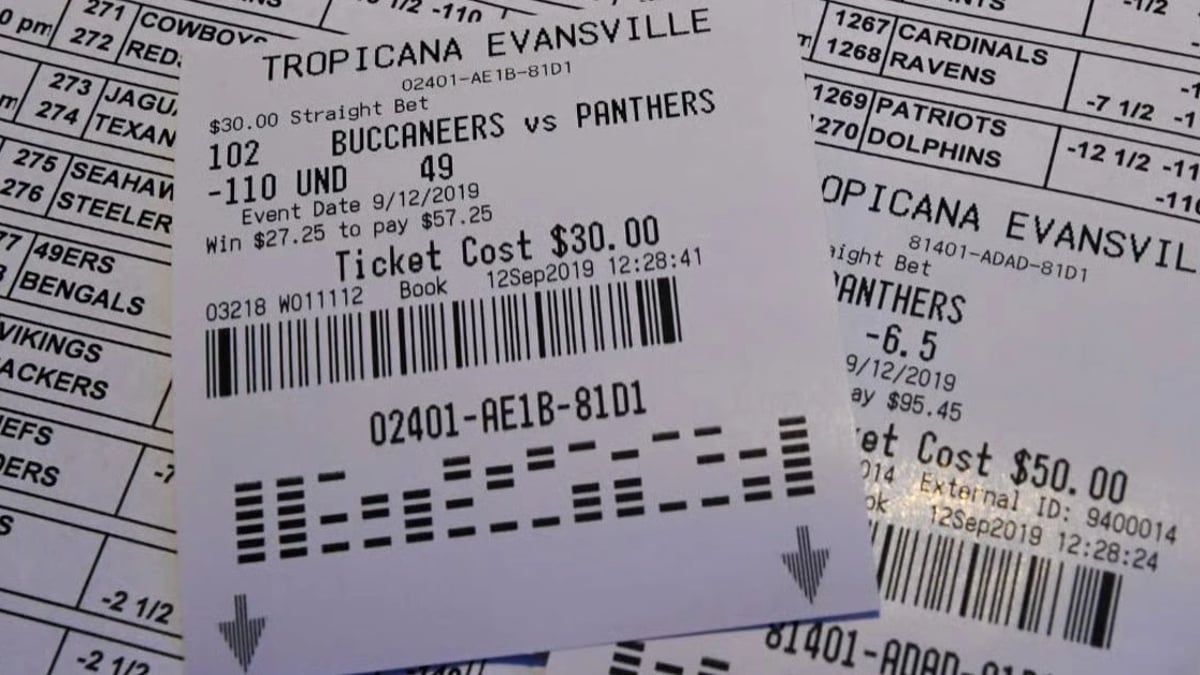Over/Under Betting Strategy

As a sports bettor, it’s important to learn the different betting types you might encounter. Totals betting—also known as over/under betting—is a simple and easy-to-understand betting option available on virtually every sport and game.
In this guide, you’ll learn how over/under betting works, strategies to improve your chances, and tips to find the best value in over/under wagers.
Note: This guide includes examples in American, decimal, and fractional odds formats. Most betting sites allow you to toggle between formats in your account settings. Currency references use U.S. dollars ($), but the same betting principles apply no matter your local currency or preferred odds display.
- #ad. 18+. Gamble Responsibly. Gambleaware.org. Must be 21+ and present in OH. Gambling Problem? Call 1-800-GAMBLER
What is Over/Under Betting?
When placing a totals wager, you are predicting if the final combined scores of both teams will be over or under the oddsmaker’s set line.
For example, if the over/under of a Celtics-Lakers game is set at 210.5, you can bet that the two teams will combine for 210 or fewer points (the under) or 211 or more points (the over). The oddsmakers will do plenty of statistical analysis to determine the number, and most often, they are very accurate when setting these lines, which also means you have to be as well.
Over/under betting is an excellent option if you don’t have a strong opinion about who might win, but you have a sense of whether it will be a low- or high-scoring game. You don’t need to know players that well, but you should dig into the team’s statistics and recent performances.
To be clear, you don’t pick either team to win the game when you’re totals betting; you’re just betting on the total combined score.
Understanding Odds in Totals Betting
Over/under betting can vary by sport. Still, one thing remains consistent: you won’t see the massive underdog or favorite odds that often come with moneyline wagers.
Totals betting odds are usually much more modest, typically hovering around the standard -110, which reflects a relatively balanced risk for the sportsbook on either side of the total. In other words, oddsmakers generally expect the chances of the game going over or under to be fairly even.
Looking at American odds, over/unders will usually fall within the range of -120 (indicating the outcome is more likely) to +110 (less likely). American odds are easiest to understand in $100 increments: the number shows how much you’d win or need to bet to win $100.
While most North American sportsbooks display betting odds in American format by default, you can also view totals odds as decimal or fractional.
Here’s an overview of these other two odds formats:
- Decimal odds show your total return per dollar bet. For example, 1.91 means you’d get $1.91 for every $1 wagered (including your stake).
- Fractional odds represent your profit over stake — the numerator is what you win, and the denominator is what you risk. So 10/11 means a $11 bet would win $10.
Learn more with our guide on how to read odds.
Examples of Over/Under Betting by Sport
Now that we’re a little more familiar with totals in general, let’s look at some examples:
NFL Over/Under Betting
With such high-scoring games in most cases, over/unders can be a great way to win some NFL bets. Totals usually range in the 40s or 50s, but can be on either side of those numbers if the oddsmakers feel the game will be an outlier.
Over/under betting on NFL Sundays can be a popular option, especially early in the season when you aren’t sure about the quality of the teams and you’re uncomfortable picking a side.
Even early in the season, you can analyze offensive and defensive stats. For example, if you find out a team’s defense gives up 25 points per game against good passing offenses—and those two teams are playing one another—it’s a good sign the total could go over. However, remember that oddsmakers do their own statistical analysis, often baked into the line. Still, in this case, you might find an edge if you come across some late-breaking injury news.
Let’s look at an example of how the over/under works in the NFL. The Pittsburgh Steelers are playing the Buffalo Bills, and the oddsmakers set the line at 53 points. If you picked the over and the final score was 38-29, your bet would have won because the total was 67. Your wager would be lost if the final score were 28-24 for a combined total of 52.
Quick Tips:
- Watch the weather: Wind, rain, and snow can tank passing games and drive totals down. In indoor games, offenses tend to light up the scoreboard.
- Key numbers matter: Common scoring totals (41, 44, and 47) are more likely outcomes, so crossing them is meaningful. You can research current NFL stats and scoring trends to identify which totals are landing most often.
- Don’t ignore pace: A run-heavy offense slows down the game, making unders more likely. However, a weak team might need to abandon the run if the game gets out of hand.

NBA Over/Under Betting
You’ll notice that NBA over/under bets work pretty much the same as in the NFL, so we’ll stick with the same basic guidelines. The only difference will be that the totals will be much higher, as basketball is a higher-scoring game.
You will be trying to predict if both teams will score more or less than the oddsmakers' line again, so you might see a 201-point total, which sounds high but is typical in the NBA.
When the number doesn’t have a half-point attached to it (and this is true of over/unders in all sports), as is the case in our example, there is a risk of a push if the total ends up hitting exactly 201. The bet would result in a “push” (tie), meaning you would receive your stake back. If the final score is 106-102—a combined total of 206, the over would be the winning bet.
Quick Tips:
- Consider pace: Look at possessions per game, as up-tempo teams create more scoring chances. Conversely, plodding teams tend to suppress scoring.
- Pay attention to the schedule: Over the course of the season, all NBA teams will have multiple back-to-backs, meaning they play games on two consecutive days. Fatigued teams often underperform offensively.
- Matchups drive tempo: Two defensive-minded teams can make an under look tempting. However, oddsmakers factor this into the line, so tread carefully.

NHL Over/Under Betting
At the other end of the spectrum, hockey games have much lower scoring. When you’re betting on the NHL, those “points” are actually goals—it’s all about whether both teams will combine to score more or fewer goals than the number set by the sportsbook. Hockey totals usually end up being in the 5-10-goal range. Many games will result in 4-2, 5-3, or 1-0 tallies.
Keeping an eye on goaltender stats and which teams may be top scorers on the opposing team will help you with NHL over/under betting.
Quick Tips:
- Goalie status is critical: A backup in the net can dramatically swing the total.
- Style of play matters: Some teams play tight defensive games, others trade chances.
- Empty net goals affect totals: Teams that lose in the last few minutes of a game almost always pull their goalie to get another attacker on the ice. So beware of those last-minute over-busters.

MLB Totals Betting
Betting on the over/under in baseball can be a little more interesting, as you will need to pay attention to various other aspects, like the batting order or who is pitching (similar to paying attention to who the starting goaltender is in hockey). A typical total in MLB betting is 7.5, meaning you’re wagering whether both teams will combine for seven or fewer runs (the under) or eight or more runs (the over).
If we’re betting on the Braves vs. the Phillies and the total is 7.5, we will first need to look at the starting pitchers and the strength of each team's batting order to determine how we want to approach an over/under bet. The over would be the winning bet if the final score were 6-3 (9 total runs).
Quick Tips:
- Check the starting pitchers: A strong ace vs. a struggling lineup often favors the under. This is factored into the line. Analyze a strong starting pitcher’s previous performance against the opponent.
- Weather + ballpark = edge: Wind blowing out at Wrigley in Chicago can spike overs. Conversely, Oracle Park in San Francisco punishes home run hitters with its deep dimensions and windy, damp, and cool conditions.
- Bullpen usage: A tired bullpen may leak runs late, helping overs. You can use a website like FanGraphs, which tracks bullpen usage, for research.

Soccer Over/Under Betting
Soccer (football) can be a really tricky sport to bet on totals, as it is one of the lowest-scoring sports in the world. The totals are usually pretty low—betting sites often set the total around 2.5 or 3.5 goals. Soccer games frequently end in a draw (tie), so the unders are extremely juicy in soccer betting.
A 3.5 over/under would mean the final score would need to be 2-1 (three total goals) for the under to cash, and if you picked the over, a score of 4-2 would be a winner. Over/under betting is one of the many exciting goal betting markets.
Quick Tips:
- Form and fatigue: Clubs on short rest or with rotation squads may struggle to score. Stay up-to-date on the news.
- League trends: Some leagues are more goal-heavy than others. Be aware of the playing style typical of each league.
- Weather and pitch quality: Like the NFL, rain or poor pitch conditions can slow the game down, so watch the weather.

Over/Under Betting FAQs
What is a totals bet?
An over/under bet is when you place a wager on the total number of points scored by both teams collectively in a game. If two teams compete against one another, you will add their final scores together to get the total. You must determine if the final score will be over or under the betting site’s line.
Do you have to pick a winner in over/under betting?
No, you don’t have to pick either team to win the game when you’re betting the over/under. You can be impartial toward the teams playing and strictly bet on the number of points you believe will be scored in the game.
Are totals and over/under bets the same?
Yes. Most betting sites call it "totals betting," but you’ll often hear people refer to it as an "over/under" bet for obvious reasons.
What if the total is the same as the final score?
If the total doesn’t involve a half point, there is a chance that the actual score could be the same as the total. In this case, your bet would be ruled a push, and your initial stake would be refunded.














